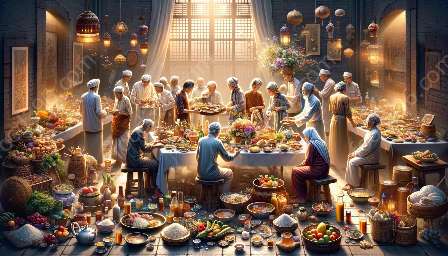Food culture is shaped by a multitude of factors, including gender roles and identity. Throughout history, human societies have assigned specific roles to men and women regarding food production, consumption, and culinary practices. The intertwining of food culture and gender roles reflects deeply rooted traditions, social norms, and perceptions of identity. Examining this intersection allows us to gain insights into the complexities of cultural heritage and the evolution of food as a marker of individual and collective identity.
Food and Identity
Food is a powerful symbol of identity, reflecting not only individual preferences but also broader cultural, ethnic, and gender-based affiliations. The link between food and identity encompasses a wide range of elements, including regional cuisines, culinary traditions, and the social rituals surrounding food. Gender-specific roles within food preparation and consumption further contribute to the intricate web of identity construction.
Cultural Signifiers
In many societies, food preparation and cooking have been historically associated with women, emphasizing their roles as nurturers and caregivers. This association has perpetuated the notion of certain dishes or cooking techniques being inherently feminine, thereby influencing the gendered construction of identity through culinary practices. Conversely, the depiction of men as providers or hunters in some cultures has contributed to their association with specific types of food production and consumption, thereby shaping their culinary identities.
Food Culture and History
The historical context of food culture provides a lens through which we can understand the complex interplay between gender roles and culinary traditions. Throughout various historical periods, shifts in societal structures, economic conditions, and cultural influences have impacted the division of labor and gendered roles within food-related activities.
Historical Perspectives
In ancient societies, the division of labor often dictated that men were responsible for hunting and gathering while women were tasked with food preparation and domestic cooking. These gendered roles in food production and consumption not only shaped individual identities but also contributed to the dietary habits and culinary customs of entire communities.
Colonial Influences
The colonial era brought about significant transformations in food cultures and gender roles. The introduction of new crops, cooking techniques, and culinary ingredients often led to adaptations in traditional gender roles and food-related practices. Furthermore, the influence of colonization on food distribution and availability had a pronounced impact on the gendered dimensions of food provisioning and consumption within various societies.
Intersection of Gender, Food, and Identity
The intersection of gender, food, and identity can be observed through the lens of food symbolism, culinary practices, and social rituals. The cultural and historical dimensions of gender roles within food culture provide valuable insights into the intricate ways in which food shapes individual and collective identities.
Challenging Traditional Norms
Contemporary perspectives on gender roles in food culture are challenging traditional norms and redefining the relationship between food and identity. Efforts to break down gender-based stereotypes in culinary professions, as well as the recognition of diverse gender expressions in relation to food consumption and production, are reshaping the narrative of traditional gender roles within food culture.
Expressing Identity Through Food
Individuals and communities use food as a means of expressing their identity, and this extends to the subversion of traditional gender roles. Through alternative culinary practices, reinterpretations of traditional dishes, and the celebration of diverse gender identities, food culture becomes a platform for expressing multifaceted and evolving identities.
Conclusion
The exploration of the intersection between gender roles, food culture, and identity provides a rich understanding of the ways in which historical, cultural, and societal factors have shaped culinary traditions and individual identities. By recognizing the complexities of gender roles within food culture, we can appreciate the diverse narratives and expressions of identity that are woven into the fabric of food and its significance in human experience.

